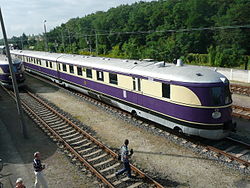History


Prussian period
In 1816, Carl Johann Bernhard Karsten proposed the first railway project to connect Upper Silesia with Wrocław. The double-track, steam-powered line, spanning over 200 km, was primarily designed for coal transport, with provisions for passenger services. The project was rejected in Berlin due to the lower cost of transporting coal via the Oder river. [1]
On 3 June 1836, the Silesian bourgeoisie established the Founding Committee of the Upper Silesian Railway (German: Oberschlesische Eisenbahn), led by Count Püchler, president of Oppeln. Disputes over the route eastward from Opole limited initial construction to the section from Wrocław to Opole Zachodnie, completed on 29 May 1843. [2] The final route from Opole to Nowy Bieruń via Gliwice was approved in October 1842. The section to Gliwice opened on 2 October 1845, followed by Świętochłowice two weeks later. The line reached Mysłowice on 3 October 1846, though the planned extension to Bieruń was never built. [1] The 196.3 km line was inaugurated by Prussian King Frederick William IV. [3] The Gliwice Łabędy railway station (German: Laband) also opened in 1846. [2]
In 1846, Gliwice connected to the Prussian railway network via the Berlin–Wrocław railway (German: Niederschlesisch-Märkische Eisenbahn), linking Berlin with Wrocław. [2] In 1847, connections to the Kingdom of Galicia and Lodomeria were established through the Kraków–Upper Silesia railway (German: Krakau-Oberschlesische Eisenbahn), connecting Kraków to Mysłowice . Two years later, access to the Congress Poland was enabled via the Warsaw–Vienna railway. [2]
In 1872, the Upper Silesian Railway opened a line to Bytom, and in 1879, a second line to Opole, bypassing Kędzierzyn-Koźle . [2] In 1883, the railway was nationalized by the Royal Prussian Railway Administration (German: Königlich Preußische Eisenbahn-Verwaltung), which opened a line to Katowice Ligota in 1904. In 1924, Polish State Railways opened a line from the Polish-German border at Gierałtowice , enabling a direct connection to Rybnik , located in Poland after World War I. [2]
In 1895, wagon repair workshops (German: Hauptreparatur-Werkstatt) were commissioned, later becoming the Gliwice Wagon Factory Holding S.A.. [3] On 1 October 1904, the Royal Railway Locomotive Workshops (German: Königliche Eisenbahn-Lokomotivwerkstätte) began operations, functioning as the Locomotive Repair Plant from 1971. [4]
On 25 March 1899, the Upper Silesian Steam Tramways (German: Oberschlesische Dampfstrassenbahnen AG, ODS) opened a narrow-gauge line with a 785 mm gauge from Gliwice Trynek to Rudy . The Gliwice–Racibórz railway was completed in Ratibor Plania in 1903. [5]
In 1913, the first plan to expand the station to its current size was proposed, undergoing several revisions before implementation. Reconstruction of the station's surroundings began in 1923, with the station itself starting on 24 April 1924 and completed on 9 December 1925. [3]
From 15 May 1936 to 21 August 1939, the Flying Silesian (German: Fliegender Schlesier), a luxury express train, operated between Berlin-Charlottenburg and Bytom via Gliwice. Reaching speeds of up to 160 km/h, it was among the fastest trains globally at the time, with a journey from Bytom to Berlin Silesian Station taking 4 hours and 24 minutes. [6]
In 1939, the Gliwice Canal (German: Gleiwitzer Kanal) was completed, ending at the Gliwice Port in Łabędy , served by the Gliwice Port railway station . [3]
Polish period


In December 1952, an express connection to Warsaw was launched using a diesel railcar MsBx , replaced in 1958 by an electric multiple unit E58 as the express Górnik. [3]
In the 1950s, intensive railway electrification began: the line to Katowice was electrified on 1 June 1957, to Opole via Strzelce Opolskie on 3 October 1960, to Kędzierzyn-Koźle on 18 July 1962, to Katowice Ligota on 8 September 1977, and to Bytom on 23 December 1980. [2]
Starting in the 1960s, passenger services were gradually discontinued: to Racibórz Markowice on 1 July 1966, [7] to Lubliniec on 15 October 1973, [2] to Rudy on 4 November 1991, [5] to Jastrzębie Zdrój on 9 January 1995, to Katowice Ligota and beyond on 1 June 1997, and to Rybnik on 28 November 2000. [2] The connection to Bytom was discontinued on 31 July 2001, reactivated on 31 January 2008, [8] and suspended again on 1 March 2012. [9]
In 1992, the Górnik express was reclassified as an InterCity service, becoming the first InterCity train to stop in Gliwice. In 1993, the station was expanded with a fourth platform, constructed by dismantling the third baggage platform. [3]
In 2010, revitalization began on the line to Opole (lines Katowice–Legnica railway , Gliwice Łabędy–Pyskowice railway , and Bytom–Wrocław railway). [10] [11] On 1 October 2011, Koleje Śląskie launched trains on the Gliwice–Częstochowa route. [12] On 1 February 2013, Koleje Śląskie reactivated the Gliwice–Bytom line, [13] but suspended it again on 1 June 2013. [14] In 2013, revitalization of the line to Katowice (Katowice–Legnica railway ) began. [11]
On 13 December 2015, Express InterCity Premium trains, operated by ED250 Pendolino, began stopping in Gliwice. [15]
![E 30 railway [pl] Linia Kolejowa E 30.JPG](http://upload.wikimedia.org/wikipedia/commons/thumb/9/99/Linia_Kolejowa_E_30.JPG/250px-Linia_Kolejowa_E_30.JPG)


![Siding to Sosnica Coal Mine [pl] Gliwice, Kopalnia Wegla Kamiennego Sosnica - Makoszowy, Ruch Sosnica - fotopolska.eu (296225).jpg](http://upload.wikimedia.org/wikipedia/commons/thumb/1/16/Gliwice%2C_Kopalnia_W%C4%99gla_Kamiennego_So%C5%9Bnica_-_Makoszowy%2C_Ruch_So%C5%9Bnica_-_fotopolska.eu_%28296225%29.jpg/250px-Gliwice%2C_Kopalnia_W%C4%99gla_Kamiennego_So%C5%9Bnica_-_Makoszowy%2C_Ruch_So%C5%9Bnica_-_fotopolska.eu_%28296225%29.jpg)


